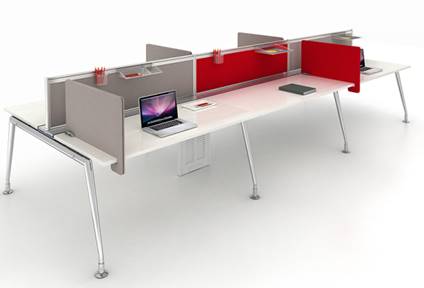Modern and Sleek: Exploring Contemporary Office Furniture Trends
Office spaces have evolved to reflect the changing needs and preferences of employees. The modern workplace now embraces contemporary office furniture trends that prioritize functionality, aesthetics, and employee well-being. From sleek minimalist designs to innovative ergonomic solutions, let's delve into the exciting world of contemporary office furniture.

What is Modern office design?
Modern office design refers to a contemporary approach to designing and arranging office spaces that reflects current trends, preferences, and work practices. It is a departure from traditional office layouts and aesthetics, which were often characterized by closed cubicles, limited natural light, and rigid hierarchies.
Modern office design focuses on creating functional, flexible, and inspiring work environments that promote productivity, collaboration, and employee well-being. It embraces open floor plans, shared workspaces, and the integration of technology to foster communication and teamwork.
What is the difference between a modern office and a traditional office?
The difference between a modern office and a traditional office lies in their design, layout, and approach to work. Here are some key distinctions:
|
Aspect |
Modern Office |
Traditional Office |
|
Layout and Space Utilization |
Open floor plans with fewer barriers and partitions |
Closed layouts with individual cubicles or enclosed offices |
|
Aesthetics and Design |
Minimalist, contemporary design with clean lines |
Formal, conservative aesthetic with heavy furniture |
|
Technology Integration |
Strong emphasis on technology integration |
Limited technology integration |
|
Workstation Design |
Flexible workstations shared desks, ergonomic furniture |
Fixed desks or cubicles assigned to each employee |
|
Employee Well-being |
Amenities for well-being, access to natural light |
Fewer amenities, more formal approach to well-being |
|
Organizational Culture |
Agile, collaborative, and innovative culture |
Hierarchical and structured culture |
Exploring Contemporary Office Furniture
Contemporary office furniture encompasses the latest trends and designs that cater to the evolving needs and preferences of modern workplaces. It goes beyond mere functionality and focuses on creating aesthetically pleasing, comfortable, and productive work environments. Let's explore some key aspects of contemporary office furniture:
-
Minimalism and Clean Lines:
Contemporary office furniture is characterized by its minimalist approach and clean lines. Simple geometric shapes, sleek surfaces, and uncluttered designs create a sense of openness and spaciousness. Minimalistic desks, chairs, and storage units not only enhance the visual appeal of the office but also promote a clutter-free and organized workspace.
-
Ergonomic Excellence:
Employee well-being has become a paramount concern for organizations, and contemporary office furniture reflects this shift. Ergonomics plays a crucial role in designing furniture that supports the health and comfort of employees. Adjustable standing desks, ergonomic chairs with lumbar support, and monitor arms that promote proper posture are just a few examples of how modern office furniture prioritizes employee health and productivity.
-
Flexible and Collaborative Spaces:
The rise of remote work and the increasing emphasis on collaboration have led to the creation of flexible and adaptable office spaces. Contemporary furniture is designed to cater to the changing needs of a dynamic workforce. Modular desks, movable partitions, and versatile seating arrangements allow for easy reconfiguration of the office layout, fostering collaboration and accommodating different work styles.
-
Sustainable Materials:
With the growing awareness of environmental concerns, contemporary office furniture trends are embracing sustainability. More and more organizations are opting for furniture made from eco-friendly materials such as recycled wood, bamboo, or metal. Additionally, sustainable manufacturing practices, including the use of low-emission finishes and energy-efficient production methods, contribute to reducing the carbon footprint of office furniture.
-
Technology Integration:
Technology integration is a crucial aspect of contemporary office furniture design. Desks and tables equipped with built-in charging stations, wire management systems, and smart features like wireless charging pads and integrated connectivity ports are becoming increasingly popular. These furniture solutions enable seamless integration of technology into the workspace, enhancing productivity and connectivity.
-
Biophilic Design:
The incorporation of nature into the office environment has gained significant traction in recent years. Biophilic design principles, which aim to reconnect people with nature, are now influencing contemporary office furniture trends. Natural materials, living green walls, and furniture designs inspired by organic forms are being embraced to create a more harmonious and stress-free work atmosphere.
-
Personalization and Customization:
Contemporary office furniture recognizes the importance of individuality and personalization. Employers are increasingly investing in furniture solutions that allow employees to create their own unique workspace. Adjustable desks, customizable storage units, and modular seating options empower individuals to tailor their work environment to suit their specific needs, enhancing comfort and productivity.
The world of office furniture is evolving rapidly, reflecting the changing nature of work and the evolving expectations of employees. Contemporary office furniture trends emphasize sleekness, functionality, employee well-being, and sustainability. By incorporating minimalist designs, ergonomic excellence, and flexible spaces, organizations can create work environments that inspire creativity, collaboration, and productivity. As we move forward, the office of the future will continue to adapt and evolve to meet the ever-changing needs of the modern workforce.
- 06.06.2023